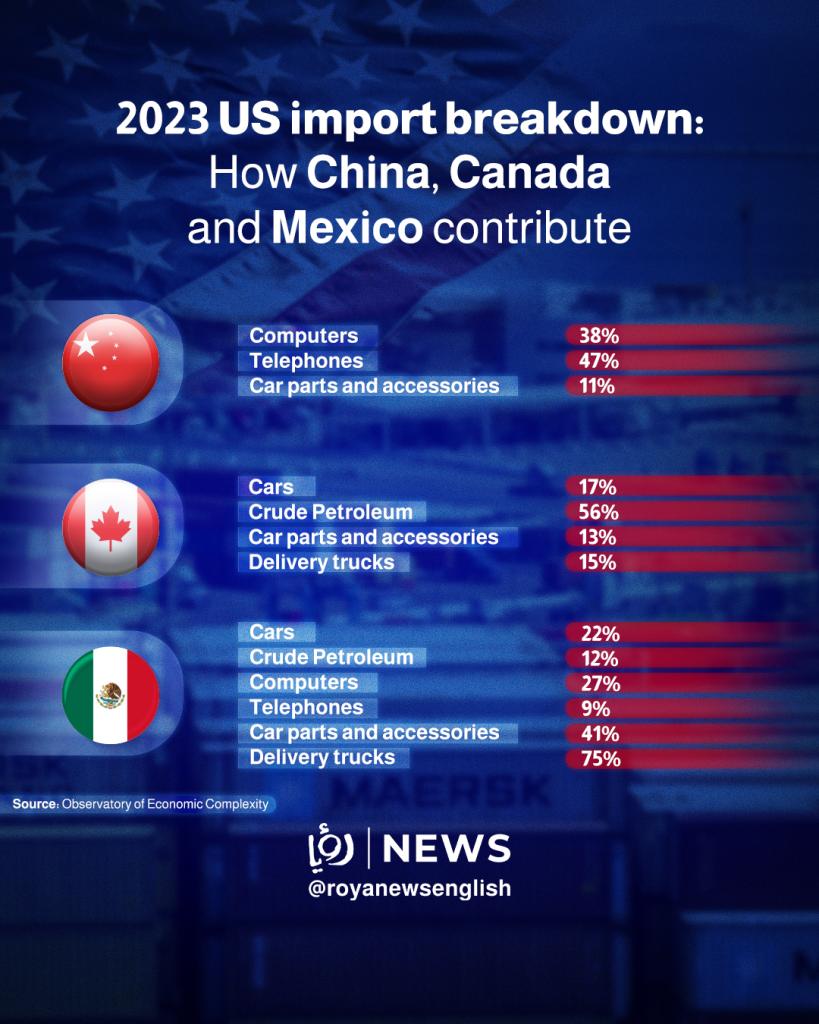(Photo: Getty Images)
US trade relations with China, Canada, and Mexico: Impact of ongoing tensions
Trump administration announced on Saturday that it would impose heavy tariffs on Mexico, Canada, and China — three of the United States' largest and most integral trading partners.
Combined, these nations represent over a third of US imports, accounting for more than USD 1 trillion in goods annually.
Read more: USAID website goes dark amidst Trump’s overhaul
Canada and Mexico, in particular, have been close trade allies since the 1990s when the North American Free Trade Agreement (NAFTA) was implemented, eliminating most tariffs and setting in motion the removal of regulatory barriers.
In 2023, for the first time, the United States imported more goods from Mexico than from any other country, signaling a major shift in global trade dynamics amidst rising tensions with Beijing.
Cars, in that year, topped the list with imports valued at USD 208 billion, followed by crude petroleum at USD 165 billion, primarily sourced from Canada. Computers and telephones were also significant imports in the US, with China being a major supplier. Car parts, delivery trucks, and other vehicles round out the top categories, with Mexico contributing a large share.

In response to these tariff threats, Canada and Mexico have promised to retaliate with their own tariffs on US exports, echoing the trade war that began during the Trump administration's first term.
As reported by Reuters, these new tariffs could lead to immediate consequences for importers, potentially raising costs for products crossing the border. In the short term, supply chains could be disrupted, and product shortages may emerge if businesses choose not to absorb the added costs. Over time, these tariffs could be passed onto consumers, driving up prices and slowing economic growth.
While the trade conflict with Mexico and Canada has been temporarily averted, tensions between the US and China remain unresolved. On Tuesday, both nations imposed tariffs on each other, with no sign of recent communication between their leaders. In 2022, China, Canada, and Mexico were the top three sources of US imports, making up about 45 percent of the USD 3 trillion total. On the export side, these countries also accounted for nearly 39 percent of all US exports, valued at USD 2 trillion.
Exports
China remains the leading destination for US goods, but its share has decreased since the trade war began in 2018, dropping from 8.7 percent in 2017 to 7.7 percent in 2022. Conversely, the US received 14.8 percent of China's exports in 2022, a decrease from 18 percent in 2017-2018. Canada and Mexico continue to be vital markets for US exports, with the US receiving 77 percent of Canadian exports and 75 percent of Mexican exports in 2022. Both nations also rank as China's second-largest trading partners.
Imports
The US remains the dominant source of imports for Canada and Mexico, supplying 56 percent of their total import value in 2022. Mexico's top imports from the US include machinery, electronics, and energy products, while Canada’s key imports are cars and machinery.
China’s imports, on the other hand, come from the US, South Korea, and Japan, with soybeans as the top US export to China in recent years. However, US tariffs have allowed Brazil to increase its share of China’s agricultural imports, eroding US competitiveness.
The ongoing trade tensions with these key partners are likely to continue to disrupt these intricate trade flows, with potentially significant economic implications for both the US and its global trading partners.




